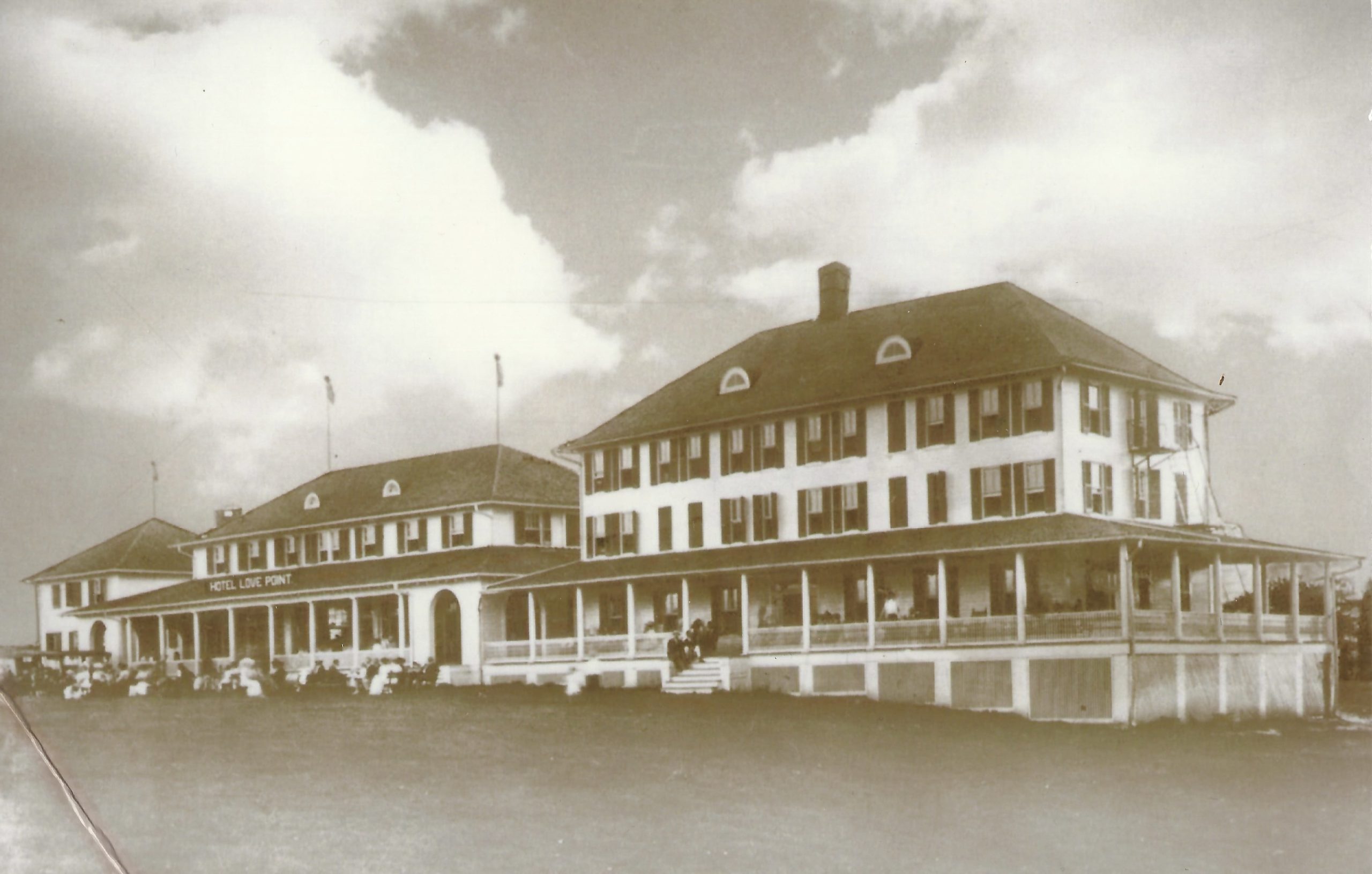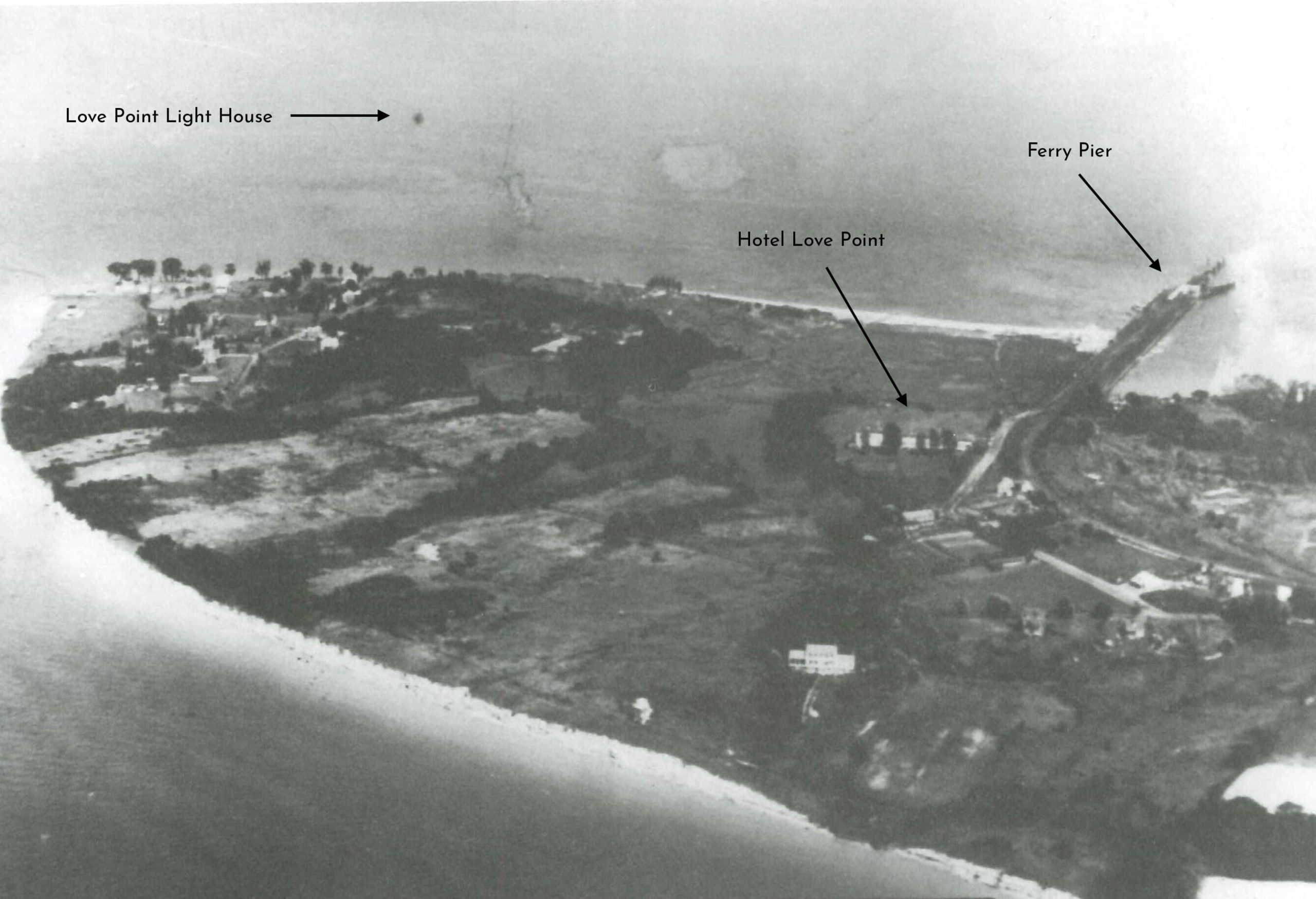
Love Point and Maryland’s Forgotten Resort
“This was Love Point—a place of wonder, as close to magic as you could find.”
- J. Coursey Willis

Love Point on Kent Island was once a haven for travelers, dreamers, and romantics seeking escape. The railways and ferries that served it opened a gateway, ushering visitors from Baltimore and beyond to Maryland’s Eastern Shore, a place of natural beauty and small-town magic. This lively era lasted about 50 years, until improved roads and the Chesapeake Bay Bridge brought change, quietly ending the spell. This story draws from my research and the memories of historians Brent Lewis, Nick Hoxter, and Janet Freedman, to whom I owe my thanks and a strong recommendation of their work. It also includes the recollections of one special man who lived at Love Point during its golden era, Mr. Phil Kemp, and the memories of my grandmother, Donna May Bryan.
Imagine it’s Saturday, July 4, 1914. The railroad stretches across Kent Island from the Kent Narrows to its northernmost point, Love Point. A vibrant scene unfolds—laughter and excitement fill the air as the pulse of summer life beats along the water’s edge. People arrive by rail and automobile from the east and by ferry from Pier 5 on Light Street in Baltimore to the west. The screech of the train coming to a stop and the steam whistles of the Smokey Joe and Westmoreland ferries echo across the shoreline. This was the first breath of Love Point—a place of wonder.
From the massive 100-foot-wide, 1,250-foot-long rail and ferry pier, you take in all there is to see. Nearby, along the tracks, Rudy Messerschmidt’s restaurant, bar, and dance hall beckon—a favorite stop for travelers, with tables set for bowls of chicken, fish, and oysters, all for 25 cents. Just beyond, children build sandcastles on the beach stretching to the Chester River, where others bask in the sun-dappled water. In the distance, the Love Point Lighthouse stands tall, guiding boats through the channel. Up the hill, a Ferris wheel and a merry-go-round twirl, inviting young and old alike to join the fun.
South of the tracks, in a marshy area, a small house rents rowboats for exploring the Chester. And on the hill, along the oyster-shell road, stands the majestic Hotel Love Point. A short walk from the pier, the grand three-story hotel with 50 rooms and an expansive front porch serves some of the Eastern Shore’s finest meals. Just beyond it is the Hotel Fillmore. Further along the shell-lined road there’s a post office, and at the intersection with Love Point Road sits Doc Mark’s Store, where travelers gather their necessities.
North of the hotels is Lake Mattapax. It’s a place for paddling and fishing, where adventurers drift across the water or find a shady spot beneath the trees of the Picnic Grove. The hum of a biplane overhead and the sight of a parachutist drifting down to earth add to the day’s spectacle.

For the young and restless, there is Camp St. Martin, not far from the pier—a rustic summer retreat drawing city kids from Baltimore looking for a break from urban life. The church camp offers simple pleasures at a price Depression-era families can afford. After a two-hour ferry ride on the Smokey Joe, campers arrive to no-frills grounds: a wooden building, a hand pump, and twice-daily swims in the bay and river. Treasure hunts, horseback riding, and campfires under the stars create memories that linger long after the ferry ride home.
As night falls, fireworks thunder and light up the sky, rivaling a nearly full moon. Afterward, an eight-piece orchestra plays until midnight in the dance hall at Hotel Love Point. Most will retire to their rooms, but a few will linger outdoors, savoring the last whispers of the night. This was Love Point in the early 1900s—a place of life and love, as close to magic as you could find.
Phil Kemp, who witnessed Love Point in its heyday, remembered it well. He spoke of weekend boarders and summer tourists gathering on the pier, watching ferries like Dream Land and Queen Caroline pull in, loaded with passengers. He recalled how locals would “go up there to see the boats go out,” women’s dresses swishing as they boarded, escorted by men in smart, tailored suits.
Back then, the hotel’s service was legendary. On busy nights, the dance pavilion would fill with people whirling to an orchestra’s tunes. Kemp remembered the 200-seat dining room serving over 500 meals in a day, with vacationers and prominent guests filling every table.
The hotel saw its share of famous faces, too. In 1908, it hosted the U.S. Clay Pigeon Shooting Championship, where a crowd watched Lester German of Wilmington win the title. The legendary sharpshooter Annie Oakley dazzled spectators as she hit marbles in midair and even a bullet off a moving target with perfect precision. And then there was Chad Link, the famed bull wrestler, who met his match here—Isaac Grollman’s bull kicked him clean off his feet, breaking the ring and scattering the crowd.
The origins of Hotel Love Point are tricky to nail down. The south wing, known originally as The Casino Hotel, was likely built between 1890 and 1900 by either Hugh L. Pope or a “Mr. Frew.” Later, the Hotel Love Point Company expanded it into the grand establishment that stood for decades. They added parlors, smoking, reading, and writing rooms, along with amusements that created a lively, carnival atmosphere. A deed from January 16, 1915, lists its many attractions: a dancing pavilion, beach, picnic grounds, and bathhouses. Known as Maryland’s “Grand Old Hotel,” it more than lived up to the name.
In the early days, there was no public road to Love Point; only the railroad could take you there. The Love Point Beach and Park Company petitioned for a public road. Eventually, the Queen Anne’s County Commissioners approved one, making the area accessible to locals who came for romantic dinners or day trips to Baltimore.
But time moves on. By the 1940s, as roads improved and the Chesapeake Bay Bridge loomed on the horizon, the crowds thinned, and Love Point grew quiet. The last ferry departed the pier on August 31, 1947, carrying just a handful of passengers, and the hotel closed that same year. For 18 years, it stood abandoned, a ghost of its former glory, decaying in the field that had once hummed with life. After years of neglect and vandalism, a mysterious fire swept through on November 12, 1965, taking what remained. The end was as grand as the beginning: smoke could be seen for miles, and in just an hour, Hotel Love Point’s story was over.
Today, little remains of the once-bustling site. At the end of Pier Road, and you can still feel echoes of a life once lived there. On the north side, you’ll see an open field neighboring Lake Mattapax where Hotel Love Point stood. At the top of the hill where the road bends was, until recently, the Hotel Fillmore. South of the road, as you near the Department of Natural Resources (DNR) gate, a gully marks where the Queen Anne Railroad once lay. The tracks linked Love Point to Stevensville, Chester, and all the way to Ocean City.
Near the Chester River, remnants of the old train and ferry pier remain. The DNR office now occupies what was once Messerschmidt’s restaurant, later known as the Anchor Inn. C.J. Langenfelder and Sons purchased these tracts in 1963, selling them to Langenfelder Marine in 2002, who repurposed the pier for marine contracting. In 2007, the State of Maryland acquired the property for the DNR, intending to transform it into a state park. With this acquisition came the decision—though for reasons unknown—to tear down the partially restored Fillmore Hotel. Yet, to this day, the land remains without a park.
Those days are gone now, but their memories remain, especially for those who saw them firsthand. My late grandmother, Donna May Bryan, remembered her aunt Addie C. Knight and uncle Joseph W. A. Evans running the hotel’s kitchen and dining hall from 1934 until its final days. She recalled sitting in the wicker chairs on the grand front porch, gazing over the lawn and the Chester River, the smell of soft crabs and fried chicken in the air. On still days, if you listen closely, you might hear it, too—the faint sounds of laughter, footsteps, and lives fully lived in a place they cherished. Spirits of a time lost, having the time of their lives.
